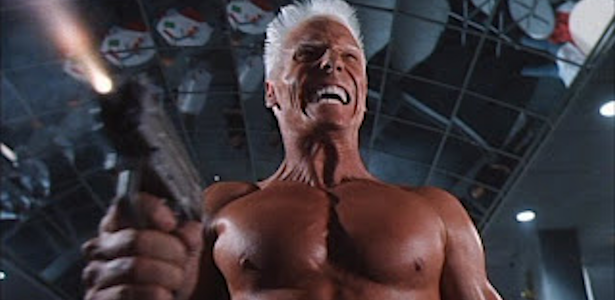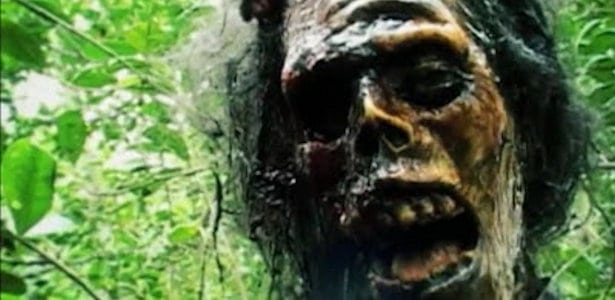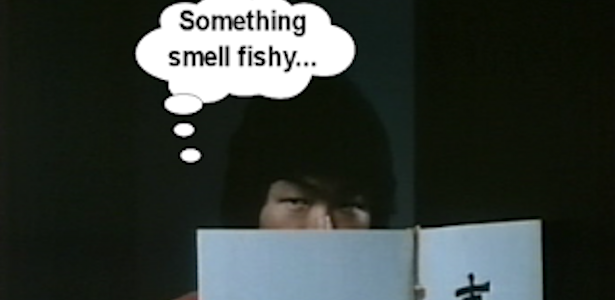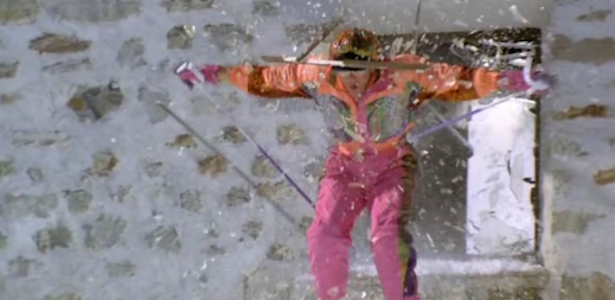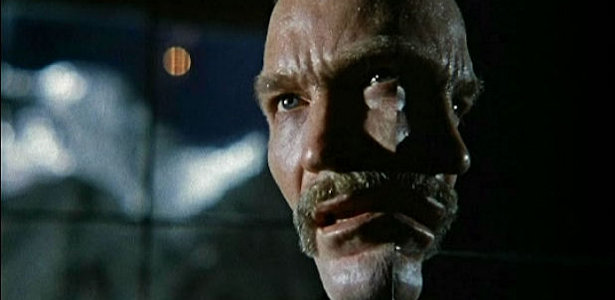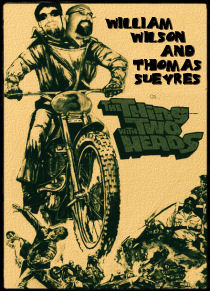Ok, so I said I could quit watching Swedish movies any time I wanted, so just to prove it I headed straight for the Video Junkie comfort zone: a low-rent slasher movie. To be totally honest, I tend to avoid most modern slasher films. At least in the '80s during the (original) slasher boom, everybody would try to throw their own twist in the tale. Say a re-incarnated viking killing campers. These days the smugness of the filmschool grads who boast their contempt for the genre with quotes that they are "making a stupid horror movie" or just as bad, do nothing but steal ideas or entire scenes from other movies and assemble them for an unwitting audience while patting themselves on the back for being so cool.
BLOOD RUNS COLD, set in North Carolina, sported a snowy, bloody trailer that advertised it was shot on a budget of $5,000. No, that is not a typo. Five thousand American greenbacks. What's more impressive is that it was shot with a common Canon EOS 7D, a digital camera that you can buy at Costco for under $2,000 with lenses! Ok, you've got my attention.
A man with a badly bleeding gash in his forehead wakes up in the snow only to find that he can't move and someone with an ax is moving in quick. Just when you think he might be able to get free, the ax comes down and we get some snowy credits with... Hey! These guys are Swedish! Doh! A presumed musician (it's only implied), Winona (Hanna Oldenburg), heads deep into the North Crackolina woods to stay at a tiny run-down old house. The house was provided by her manager, who is clearly not interested in her well being as it has no insulation, no heat, and since everyone goes outside to piss, unless it is a plot convenience (it is), no lavatory facilities. Oh and there's an ax-wielding maniac running around outside.
 Getting bored with the rats, banging shutters and the run-down, creepy house, Winona heads off to the local watering hole, The Dart Room. Decorated with Lowenbrau banners, soccer pennants and trophies, where everyone (the six other people who are in the bar) drinks Budweiser (and Carlsberg), has tattoos with foreign names and listens to bad, unplugged emo rock (wait, was that redundant?). This lets you know that it's an American bar, if you couldn't tell from the guy in the corner who is being loud, vulgar and saying "fuck" every other word. Never mind that nobody speaks with any accent other than a Scandanavian one. Turns out, one of the guys in the corner, Rick (Patrick Saxe), is Winona's ex-boyfriend, who she broke up with to go pursue her career, apparently elsewhere. Because fucking Carl (Andreas Rylander) is fucking bored, Winona invites the boys and Carl's girlfriend Liz (Elin Hugoson), back to the house to get their drink on. Actually she just says "do you want to see a creepy old house" and apparently fucking Carl is so fucking bored that this sounds like a really fucking great idea. This is actually a good thing as I was thinking it was going to be one slow slay-ride with just a single character. Even so, man, I sure hope fucking Carl is the first one to fucking go.
Getting bored with the rats, banging shutters and the run-down, creepy house, Winona heads off to the local watering hole, The Dart Room. Decorated with Lowenbrau banners, soccer pennants and trophies, where everyone (the six other people who are in the bar) drinks Budweiser (and Carlsberg), has tattoos with foreign names and listens to bad, unplugged emo rock (wait, was that redundant?). This lets you know that it's an American bar, if you couldn't tell from the guy in the corner who is being loud, vulgar and saying "fuck" every other word. Never mind that nobody speaks with any accent other than a Scandanavian one. Turns out, one of the guys in the corner, Rick (Patrick Saxe), is Winona's ex-boyfriend, who she broke up with to go pursue her career, apparently elsewhere. Because fucking Carl (Andreas Rylander) is fucking bored, Winona invites the boys and Carl's girlfriend Liz (Elin Hugoson), back to the house to get their drink on. Actually she just says "do you want to see a creepy old house" and apparently fucking Carl is so fucking bored that this sounds like a really fucking great idea. This is actually a good thing as I was thinking it was going to be one slow slay-ride with just a single character. Even so, man, I sure hope fucking Carl is the first one to fucking go.
Once back at the house, they listen to the same emo unplugged band that we heard at the bar (damn, they must be popular in the south), drink more Bud, piss in the snow, Carl says "fuck" about 20 more times, then everyone heads off to bed. There's some attempt at some character-work here where Carl tries to have a deep conversation with Rick about getting back with Winona. After that we get some nudity via some badly simulated sex scenes (Rick and Winona don't seem to be having sex, so much as struggling to get out of a bear trap) and then the group starts getting picked off one by one.
Just like in Italian movies of the '80s that desperately wanted to be mistaken for American films, there are some amusing bits that really show how not American it is. When Winona first gets to the house, she takes in a grocery bag that prominently displays Oreo cookies and white bread. Yep, totally American. At the bar, Winona orders a white wine and it's served in a balloon glass, which is a red wine glass, you can't clean it with the bar glass washers and either way it's still a backwoods bar in North Carolina! On the other end of the spectrum, at one point Winona actually falls down next to a fully loaded, fully-automatic rifle that's just lying on the floor. Then I realized... oh, yeah, it's North Carolina.
 Sporting some great camera work with oblique angles and follow focus shots from first time feature filmmaker Sonny Laguna, and a very professional sounding musical score from Samir El Alaoui, BLOOD RUNS COLD is pretty damn impressive in many ways, particularly for it's $5k budget. The cheese factor of the ramshackle sets and clumsy dialogue can be easily over looked due to some graphic gore and a potentially interesting killer. I say "potentially interesting" because for some reason, the script is so completely lacking that we don't even get any cool back-story for the character. There are no creepy legends of woodland stalkers, no breaking news about institutional escapees, no incantations performed by the original occupants, no scooby doo ending, nothing whatsoever. On the one hand, I guess it's refreshing to not have the "kids" sitting around a fire talking about yet another boogieman, but on the other hand, there is no story here. At all. I dig how everything is implied about the main character (very Swedish), but nothing is implied about the killer, and if you are going to dress your killer up in that silly outfit and make him unkillable by tools and firearms, throw us some sort of bone as to who or what he is or just some sort of plot. The 35,000 Kronor budget doesn't even enter into it. Writing dialogue scenes that advance a plot are free, and if time is an issue, ditch fucking Carl's lame dialogue about how he pulled down his pants at work or goofing off with his poor girlfriend who is trying to have a conversation with the jackass.
Sporting some great camera work with oblique angles and follow focus shots from first time feature filmmaker Sonny Laguna, and a very professional sounding musical score from Samir El Alaoui, BLOOD RUNS COLD is pretty damn impressive in many ways, particularly for it's $5k budget. The cheese factor of the ramshackle sets and clumsy dialogue can be easily over looked due to some graphic gore and a potentially interesting killer. I say "potentially interesting" because for some reason, the script is so completely lacking that we don't even get any cool back-story for the character. There are no creepy legends of woodland stalkers, no breaking news about institutional escapees, no incantations performed by the original occupants, no scooby doo ending, nothing whatsoever. On the one hand, I guess it's refreshing to not have the "kids" sitting around a fire talking about yet another boogieman, but on the other hand, there is no story here. At all. I dig how everything is implied about the main character (very Swedish), but nothing is implied about the killer, and if you are going to dress your killer up in that silly outfit and make him unkillable by tools and firearms, throw us some sort of bone as to who or what he is or just some sort of plot. The 35,000 Kronor budget doesn't even enter into it. Writing dialogue scenes that advance a plot are free, and if time is an issue, ditch fucking Carl's lame dialogue about how he pulled down his pants at work or goofing off with his poor girlfriend who is trying to have a conversation with the jackass.
My biggest gripe by far is the lack of plot, coming in second is the fact that the trailer not only shows us all of the major gore effects in the film, but one of them is a major spoiler. I really don't want to bash the film, what they pulled off with minimal resources in zero degree weather, with home camera equipment and a 35 day shooting schedule, is pretty amazing. On the other hand, it's a shame that they didn't spend a little more time writing some plot into the film, ditching some of the CGI breath effects (which you'd think would be unnecessary in zero degree weather) and trying to dial up the scare factor by creating a story and maybe a bigger climax. The real irony here is that after all of the snicker-inducing attempts to present an American slasher movie has led to them getting video releases everywhere except America. Maybe there's a lesson to be learned there; more time with the script, less time with the Americanisms. We're still pissed off about the uncomfortable furniture, kissing up isn't going to help.
BLOOD RUNS COLD, set in North Carolina, sported a snowy, bloody trailer that advertised it was shot on a budget of $5,000. No, that is not a typo. Five thousand American greenbacks. What's more impressive is that it was shot with a common Canon EOS 7D, a digital camera that you can buy at Costco for under $2,000 with lenses! Ok, you've got my attention.
A man with a badly bleeding gash in his forehead wakes up in the snow only to find that he can't move and someone with an ax is moving in quick. Just when you think he might be able to get free, the ax comes down and we get some snowy credits with... Hey! These guys are Swedish! Doh! A presumed musician (it's only implied), Winona (Hanna Oldenburg), heads deep into the North Crackolina woods to stay at a tiny run-down old house. The house was provided by her manager, who is clearly not interested in her well being as it has no insulation, no heat, and since everyone goes outside to piss, unless it is a plot convenience (it is), no lavatory facilities. Oh and there's an ax-wielding maniac running around outside.
 |
| Be it ever so humble... |
 Getting bored with the rats, banging shutters and the run-down, creepy house, Winona heads off to the local watering hole, The Dart Room. Decorated with Lowenbrau banners, soccer pennants and trophies, where everyone (the six other people who are in the bar) drinks Budweiser (and Carlsberg), has tattoos with foreign names and listens to bad, unplugged emo rock (wait, was that redundant?). This lets you know that it's an American bar, if you couldn't tell from the guy in the corner who is being loud, vulgar and saying "fuck" every other word. Never mind that nobody speaks with any accent other than a Scandanavian one. Turns out, one of the guys in the corner, Rick (Patrick Saxe), is Winona's ex-boyfriend, who she broke up with to go pursue her career, apparently elsewhere. Because fucking Carl (Andreas Rylander) is fucking bored, Winona invites the boys and Carl's girlfriend Liz (Elin Hugoson), back to the house to get their drink on. Actually she just says "do you want to see a creepy old house" and apparently fucking Carl is so fucking bored that this sounds like a really fucking great idea. This is actually a good thing as I was thinking it was going to be one slow slay-ride with just a single character. Even so, man, I sure hope fucking Carl is the first one to fucking go.
Getting bored with the rats, banging shutters and the run-down, creepy house, Winona heads off to the local watering hole, The Dart Room. Decorated with Lowenbrau banners, soccer pennants and trophies, where everyone (the six other people who are in the bar) drinks Budweiser (and Carlsberg), has tattoos with foreign names and listens to bad, unplugged emo rock (wait, was that redundant?). This lets you know that it's an American bar, if you couldn't tell from the guy in the corner who is being loud, vulgar and saying "fuck" every other word. Never mind that nobody speaks with any accent other than a Scandanavian one. Turns out, one of the guys in the corner, Rick (Patrick Saxe), is Winona's ex-boyfriend, who she broke up with to go pursue her career, apparently elsewhere. Because fucking Carl (Andreas Rylander) is fucking bored, Winona invites the boys and Carl's girlfriend Liz (Elin Hugoson), back to the house to get their drink on. Actually she just says "do you want to see a creepy old house" and apparently fucking Carl is so fucking bored that this sounds like a really fucking great idea. This is actually a good thing as I was thinking it was going to be one slow slay-ride with just a single character. Even so, man, I sure hope fucking Carl is the first one to fucking go.Once back at the house, they listen to the same emo unplugged band that we heard at the bar (damn, they must be popular in the south), drink more Bud, piss in the snow, Carl says "fuck" about 20 more times, then everyone heads off to bed. There's some attempt at some character-work here where Carl tries to have a deep conversation with Rick about getting back with Winona. After that we get some nudity via some badly simulated sex scenes (Rick and Winona don't seem to be having sex, so much as struggling to get out of a bear trap) and then the group starts getting picked off one by one.
Just like in Italian movies of the '80s that desperately wanted to be mistaken for American films, there are some amusing bits that really show how not American it is. When Winona first gets to the house, she takes in a grocery bag that prominently displays Oreo cookies and white bread. Yep, totally American. At the bar, Winona orders a white wine and it's served in a balloon glass, which is a red wine glass, you can't clean it with the bar glass washers and either way it's still a backwoods bar in North Carolina! On the other end of the spectrum, at one point Winona actually falls down next to a fully loaded, fully-automatic rifle that's just lying on the floor. Then I realized... oh, yeah, it's North Carolina.
 Sporting some great camera work with oblique angles and follow focus shots from first time feature filmmaker Sonny Laguna, and a very professional sounding musical score from Samir El Alaoui, BLOOD RUNS COLD is pretty damn impressive in many ways, particularly for it's $5k budget. The cheese factor of the ramshackle sets and clumsy dialogue can be easily over looked due to some graphic gore and a potentially interesting killer. I say "potentially interesting" because for some reason, the script is so completely lacking that we don't even get any cool back-story for the character. There are no creepy legends of woodland stalkers, no breaking news about institutional escapees, no incantations performed by the original occupants, no scooby doo ending, nothing whatsoever. On the one hand, I guess it's refreshing to not have the "kids" sitting around a fire talking about yet another boogieman, but on the other hand, there is no story here. At all. I dig how everything is implied about the main character (very Swedish), but nothing is implied about the killer, and if you are going to dress your killer up in that silly outfit and make him unkillable by tools and firearms, throw us some sort of bone as to who or what he is or just some sort of plot. The 35,000 Kronor budget doesn't even enter into it. Writing dialogue scenes that advance a plot are free, and if time is an issue, ditch fucking Carl's lame dialogue about how he pulled down his pants at work or goofing off with his poor girlfriend who is trying to have a conversation with the jackass.
Sporting some great camera work with oblique angles and follow focus shots from first time feature filmmaker Sonny Laguna, and a very professional sounding musical score from Samir El Alaoui, BLOOD RUNS COLD is pretty damn impressive in many ways, particularly for it's $5k budget. The cheese factor of the ramshackle sets and clumsy dialogue can be easily over looked due to some graphic gore and a potentially interesting killer. I say "potentially interesting" because for some reason, the script is so completely lacking that we don't even get any cool back-story for the character. There are no creepy legends of woodland stalkers, no breaking news about institutional escapees, no incantations performed by the original occupants, no scooby doo ending, nothing whatsoever. On the one hand, I guess it's refreshing to not have the "kids" sitting around a fire talking about yet another boogieman, but on the other hand, there is no story here. At all. I dig how everything is implied about the main character (very Swedish), but nothing is implied about the killer, and if you are going to dress your killer up in that silly outfit and make him unkillable by tools and firearms, throw us some sort of bone as to who or what he is or just some sort of plot. The 35,000 Kronor budget doesn't even enter into it. Writing dialogue scenes that advance a plot are free, and if time is an issue, ditch fucking Carl's lame dialogue about how he pulled down his pants at work or goofing off with his poor girlfriend who is trying to have a conversation with the jackass.My biggest gripe by far is the lack of plot, coming in second is the fact that the trailer not only shows us all of the major gore effects in the film, but one of them is a major spoiler. I really don't want to bash the film, what they pulled off with minimal resources in zero degree weather, with home camera equipment and a 35 day shooting schedule, is pretty amazing. On the other hand, it's a shame that they didn't spend a little more time writing some plot into the film, ditching some of the CGI breath effects (which you'd think would be unnecessary in zero degree weather) and trying to dial up the scare factor by creating a story and maybe a bigger climax. The real irony here is that after all of the snicker-inducing attempts to present an American slasher movie has led to them getting video releases everywhere except America. Maybe there's a lesson to be learned there; more time with the script, less time with the Americanisms. We're still pissed off about the uncomfortable furniture, kissing up isn't going to help.




